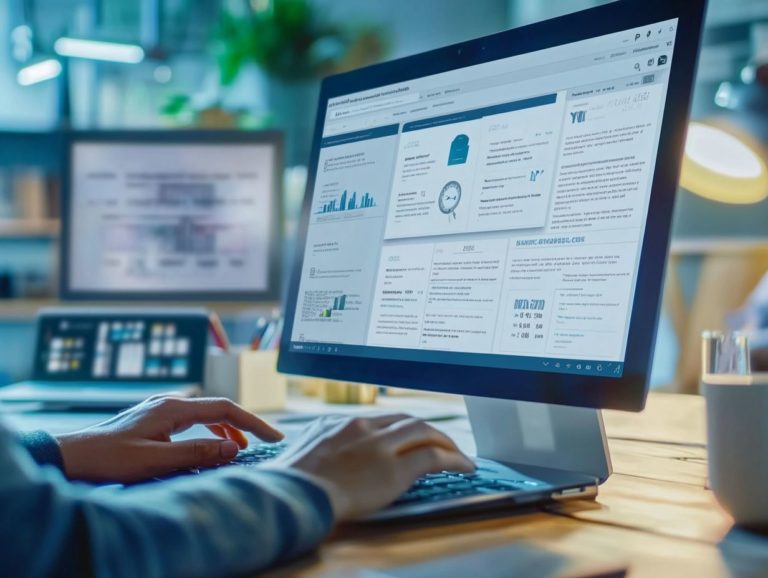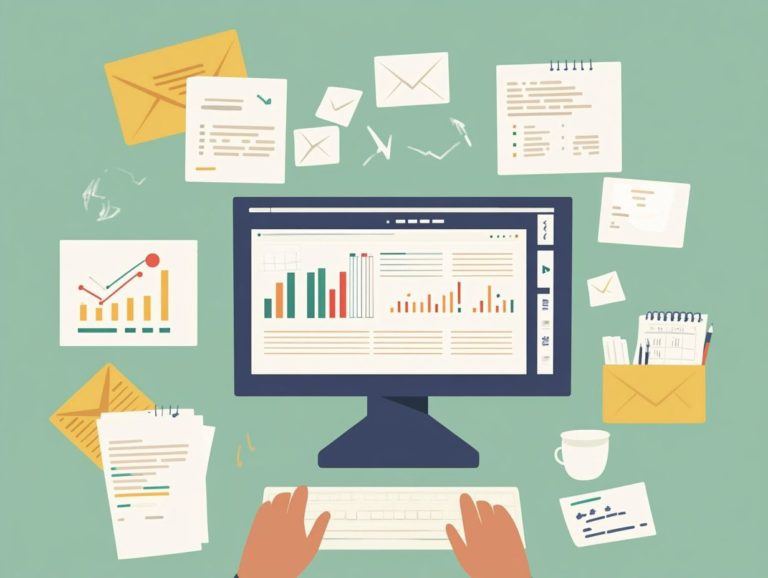How to Gather Email Feedback from Customers
Let's Set Up Your Lead Generation Strategy
Fill out the form below, and our team will get in touch with you to create a tailored solution for your business.
In today s competitive landscape, grasping your customers’ perspectives is essential for your growth and success.
Gathering email feedback stands out as one of the most effective methods to gain direct insights from your customers and enhance their overall experience.
This article delves into the importance of customer feedback, the various types of email responses you can solicit through feedback emails, and best practices for collecting and analyzing this information.
You’ll also discover strategies to encourage your customers to share their thoughts, ensuring your business continually evolves to meet their needs.
Explore how feedback can elevate your customer experience!
Contents
- Key Takeaways:
- Why Gather Email Feedback from Customers?
- Types of Email Feedback
- Let's Set Up Your Lead Generation Strategy
- Best Practices for Gathering Email Feedback
- Using Email Feedback to Improve Customer Experience
- Let's Set Up Your Lead Generation Strategy
- Tips for Encouraging Customers to Provide Feedback
- Frequently Asked Questions
- Let's Set Up Your Lead Generation Strategy
Key Takeaways:
- Gathering email feedback is your secret weapon to boost customer experience and loyalty!
- Email feedback types include surveys, reviews, and testimonials.
- Timely and well-designed surveys, along with incentives, can encourage customers to provide valuable feedback, helping businesses make informed decisions.
Why Gather Email Feedback from Customers?
Collecting email feedback from customers is an essential strategy for elevating the customer experience and driving satisfaction. By implementing thoughtfully designed feedback surveys, you can pinpoint areas ripe for enhancement in your products and services.
This approach also builds brand loyalty and facilitates automated feedback loops that streamline your communication with customers, enhancing relationships. Utilizing platforms like MailerSend can simplify this entire process, allowing you to engage your audience with personalized messages, transactional email, and targeted surveys.
Get ready to see stronger customer relationships and heightened brand trust!
The Importance of Customer Feedback
Customer feedback is absolutely essential for shaping your company’s product development and service delivery. By truly understanding your customers’ preferences and pain points, you can implement necessary improvements that elevate overall satisfaction and cultivate loyalty.
This process boosts customer engagement and strengthens your connection with them. Research shows that companies actively seeking feedback and acting on it see, on average, a 10% increase in customer loyalty and improved brand trust. For instance, consider a leading tech company that took customer insights to heart and redesigned their software interface; they enjoyed a remarkable 25% boost in user satisfaction ratings.
This clearly illustrates how valuable feedback can drive innovation, leading to an enriched customer experience, which is crucial in today s competitive marketplace.
Types of Email Feedback
You have a wealth of email feedback options at your disposal to gather valuable insights from your customers. Consider utilizing surveys, reviews, and testimonials, including a simple Net Promoter Score (NPS) for deeper insights. Each of these methods fulfills a distinct purpose and provides unique advantages in understanding customer experiences.
Embracing these avenues can significantly enhance your understanding of what resonates with your audience.
Surveys, Reviews, and Testimonials

Surveys, reviews, and testimonials are essential elements of an effective feedback strategy. Quick surveys can include open-ended questions inviting customers to share their thoughts, helping businesses establish a customer feedback loop.
Let's Set Up Your Lead Generation Strategy
Fill out the form below, and our team will get in touch with you to create a tailored solution for your business.
This loop doesn t just capture valuable insights; it deepens the understanding of customer preferences. Meanwhile, reviews and testimonials serve as compelling forms of social proof, reassuring customers of a product’s quality and the company’s reliability.
By seamlessly integrating these channels, businesses can enhance their engagement with customers, swiftly addressing concerns while highlighting positive experiences.
This proactive approach not only fosters trust but also strengthens relationships, encouraging loyalty and repeat business in an increasingly competitive landscape, similar to brands like Klook or IKEA.
Best Practices for Gathering Email Feedback
Implementing best practices for gathering email feedback is essential for maximizing response rates and obtaining invaluable insights. By understanding the optimal timing and frequency of your requests, you can significantly enhance the effectiveness of your feedback surveys and improve customer engagement. This ultimately elevates the overall customer experience.
Timing and Frequency of Requests
The timing and frequency of your feedback requests are essential for shaping customer engagement and response rates. Strategically sending feedback emails at the right moment can dramatically enhance the likelihood of receiving thoughtful responses.
Consider your customer’s journey. Reaching out shortly after a purchase or service interaction often proves effective, as the experience is still fresh in their minds. However, it s crucial to strike the right balance overwhelming your customers with too many requests can lead to feedback fatigue and discourage participation.
Incorporating a variety of methods like surveys, one-on-one interviews, or quick polls can diversify the responses you receive and boost customer interaction. When customers understand how their feedback will be utilized, they feel a sense of contribution, making them more inclined to participate meaningfully. Engaging them with personalized messages that resonate with their experiences can significantly elevate the quality of insights you gather.
Designing Effective Surveys
Designing effective surveys is crucial for gathering meaningful customer feedback. A well-structured survey considers your preferences and ensures that the questions are clear, concise, and relevant.
By concentrating on these key elements, you can create surveys that yield actionable insights and demonstrate an understanding of your customer preferences. This means using straightforward language in your survey to avoid any confusion and keeping it brief to respect your customers’ time.
Including questions that delve into your specific likes and dislikes can lead to more tailored services, enhancing your satisfaction. Well-designed surveys can make a real difference, allowing teams to pinpoint areas for improvement and leverage your feedback to build stronger relationships with clients.
Using Email Feedback to Improve Customer Experience

Leveraging email feedback effectively opens the door to big improvements in customer experience and product enhancements. By looking at customer insights and actively responding to the feedback received, you can make informed decisions that drive product improvements and enhance the overall quality of your service delivery.
How to Analyze and Act on Feedback
Looking at feedback effectively is essential for grasping customer insights and determining your next steps. You can also use usage analytics to pinpoint trends and identify areas that require immediate attention or improvement.
Beyond just usage analytics, you can also use surveys, focus groups, and social media listening to gain a well-rounded view of customer sentiments. Each of these methods offers valuable data, allowing you to interpret responses through statistical or sentiment analysis tools.
As you synthesize this information, actionable insights will emerge, highlighting specific pain points and opportunities for enhancement. For example, if a recurring service issue comes to light, you can make targeted adjustments to address it directly.
Let's Set Up Your Lead Generation Strategy
Fill out the form below, and our team will get in touch with you to create a tailored solution for your business.
Integrating these insights into your product development and customer service strategies not only enhances customer satisfaction but also cultivates loyalty and drives growth, ensuring the long-term success of your brand.
Tips for Encouraging Customers to Provide Feedback
Encouraging your customers to provide feedback is crucial in creating a robust feedback loop. By implementing effective communication strategies and offering enticing incentives, such as discounts or exclusive rewards, you can significantly boost participation rates and cultivate stronger relationships with your customers.
Join us in this journey of improvement!
Incentives and Communication Strategies
Incentives are your secret weapon for driving engagement! When paired with well-crafted ways to communicate, these incentives can significantly boost your participation rates.
By offering a variety of incentives think exciting discounts or exclusive rewards you create a genuine sense of value and appreciation. For instance, an intriguing promotional offer can prompt a one-time response and nurture ongoing loyalty and engagement.
Effective communication techniques can enhance your willingness to share feedback. Personalizing messages to resonate with your experiences is key.
When you frame requests to highlight how your insights can enhance products or services, especially through customer feedback channels, businesses can foster more meaningful dialogue. This ultimately leads to richer and more valuable feedback.
Frequently Asked Questions

What is the best way to gather email feedback from customers?
The best way to gather email feedback is by sending out a survey or feedback form directly to customers’ emails. This ensures the feedback is received and can be easily tracked and compiled for analysis.
What should be included in an email feedback form?
An email feedback form should contain clear, specific questions relevant to your business or product. Include a rating scale or open-ended questions for more detailed responses.
How frequently should I gather email feedback from customers?
Wondering how often to check in with your customers for feedback? It’s recommended to gather email feedback at least once a quarter. This allows enough time to implement changes based on feedback and observe the impact on customer satisfaction.
What can I do to encourage customers to provide email feedback?
Offering incentives, such as discounts or free gifts, can effectively encourage customers to provide feedback. Additionally, ensuring that the form is easily accessible and user-friendly makes it more convenient for customers to share their thoughts.
How should I analyze and use the email feedback gathered from customers?
Carefully reviewing and analyzing the email feedback is crucial. Look for common themes or issues that can be addressed. Make sure to take action on any suggestions or concerns, showing customers that their feedback is valued and can improve their overall experience.
How can I ensure the privacy and security of customer email feedback?
When gathering email feedback, having a secure and private system in place to protect customer information is essential. This could include using a trusted third-party survey platform or implementing stringent data protection measures within your organization.
Let's Set Up Your Lead Generation Strategy
Fill out the form below, and our team will get in touch with you to create a tailored solution for your business.






